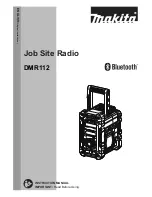
• Radio 4 (repeater) is child to radio 2 (repeater), but is parent to radios 5 and 6 (both slaves).
On the LCD of each device, the parent device address (PADR) and local device address (DADR) are shown.
MultiHop Master Radio. Within a network of MultiHop data radios, there is only one master radio. The master radio controls the overall
timing of the network and is always the parent device for other MultiHop radios. The host system connects to this master radio.
MultiHop Repeater Radio. When a MultiHop radio is set to repeater mode, it acts as both a parent and a child. The repeater receives
data packets from its parent, then re-transmits the data packet to the children within the repeater’s network. The incoming packet of
information is re-transmitted on both the radio link and the local serial link.
MultiHop Slave Radio. The slave radio is the end device of the MultiHop radio network. A radio in slave mode does not re-transmit the
data packet on the radio link, only on the local serial (wired) bus.
MultiHop Application Modes
The MultiHop radios operate in Modbus mode or transparent mode. Use the internal DIP switches to select the mode of operation. All
MultiHop radios within a wireless network must be in the same mode.
Transparent Mode
Use transparent mode for communication protocols other than Modbus. In transparent mode, the MultiHop radio packetizes data received
from the hardwired serial connection and transmits the packet to all radios within range. A wireless system by definition is a lossy link. It
is up to the host system protocol to guarantee the data integrity.
For reliable packet transmission, follow all rules for packet size and inter-character timing listed in the specifications and allow sufficient
time between packets to avoid overloading the MultiHop radio network. The time between packets varies based on the size of the net-
work.
Modbus Mode
Modbus application mode provides additional functionality to optimize RF packet routing performance and allows register-based access
and configuration of various parameters on the MultiHop radio. Modbus application mode requires that the system host device be running
a Modbus master program and that the master radio is connected directly to the host.
Packet Routing
In Modbus application mode, the master radio first discovers all connected Modbus slaves in the network, then uses the Modbus slave ID
contained in the incoming Modbus message to wirelessly route the packet only to the radio attached to the target Modbus slave. The
packet is then passed via the radio’s serial interface to the Modbus device where it is processed. This is entirely transparent to the user.
Direct packet by packet routing offers an advantage over broadcast addressing with MultiHop paths because each hop in the path can be
retried independently in the event of a packet error. This results in significantly more reliable packet delivery over MultiHop paths.
Modbus Slave IDs 01 through 10 are reserved for slaves directly connected to the host (local I/O). As such, polling messages addressed
to these devices are not relayed over the wireless link. Use Modbus Slaves IDs 11 through 61 for remote Modbus slaves — devices
serially connected to a data radio — allowing a maximum of 50 attached devices.
The figure below illustrates a basic wireless network operating in Modbus application mode. Slave devices may be any Modbus slaves,
including Banner's DX85 Modbus RTU Remote I/O devices or DX80 Gateways.
MultiHop Radio Product Manual
151317 Rev 0
www.bannerengineering.com - tel: 763-544-3164
5






































